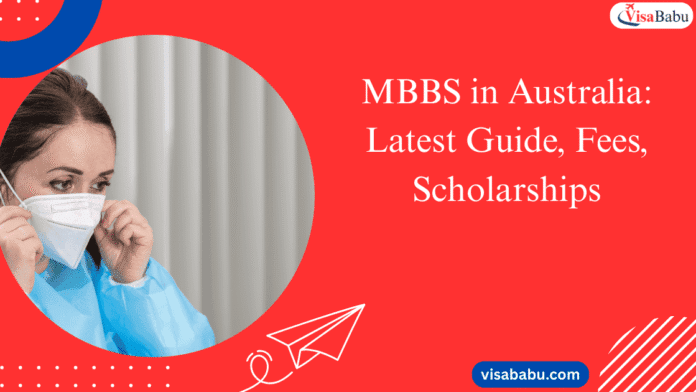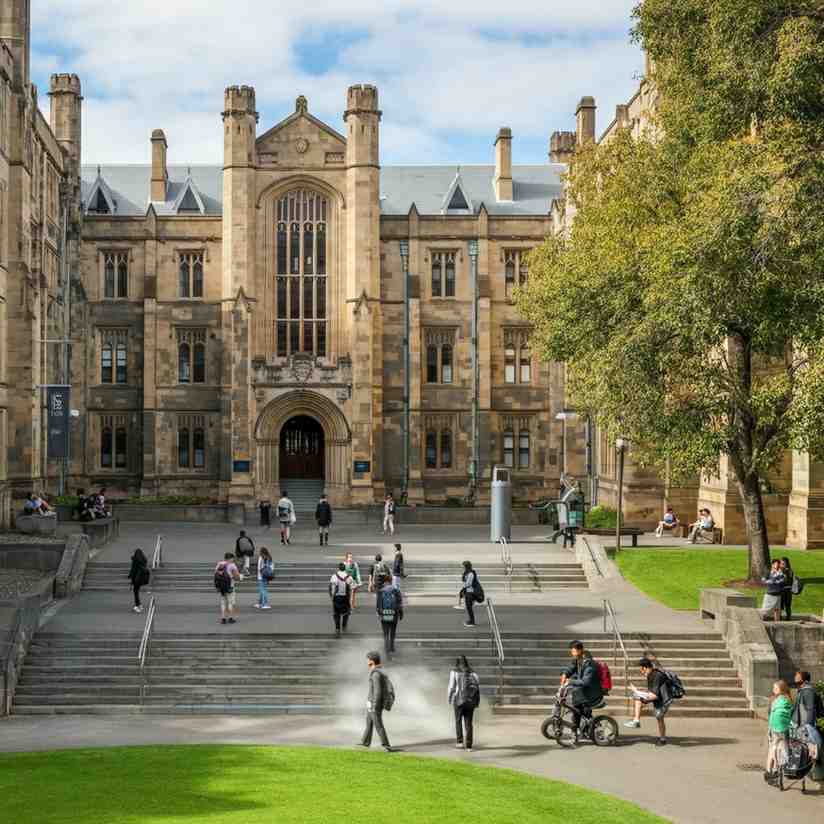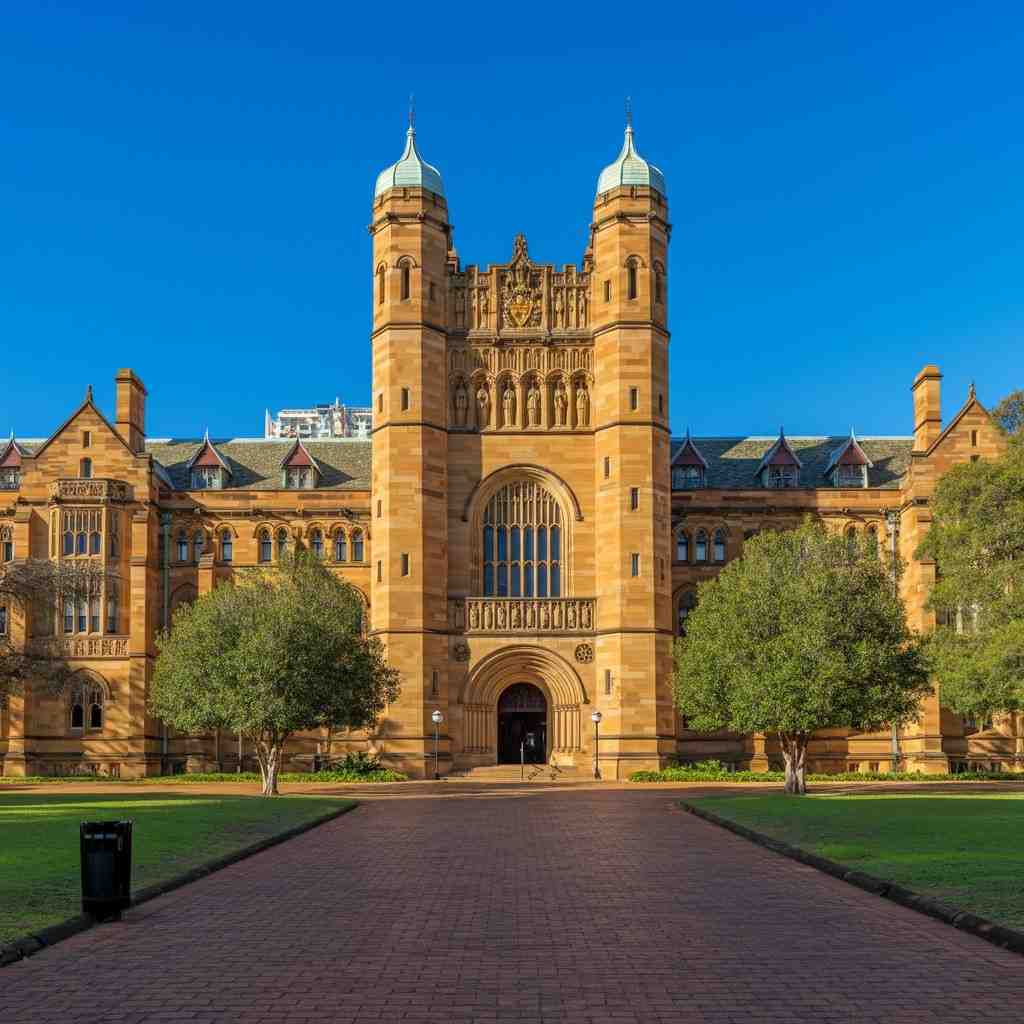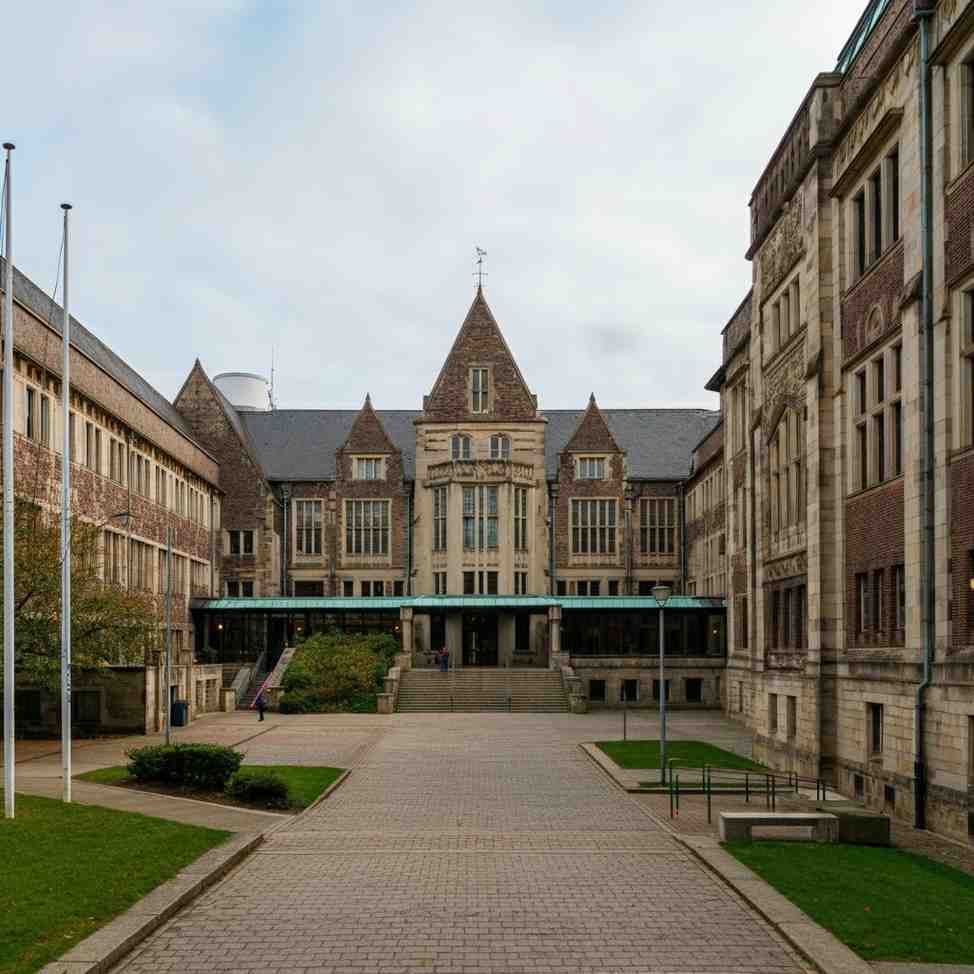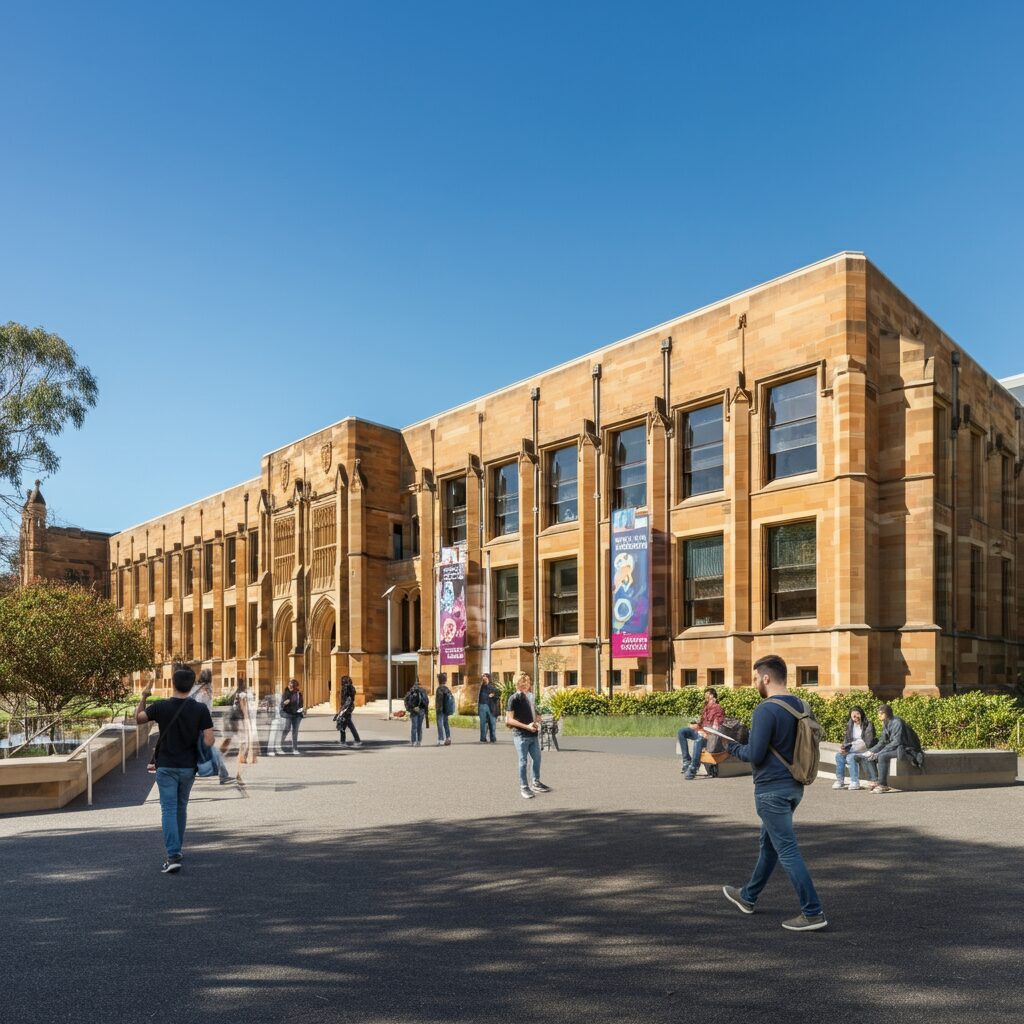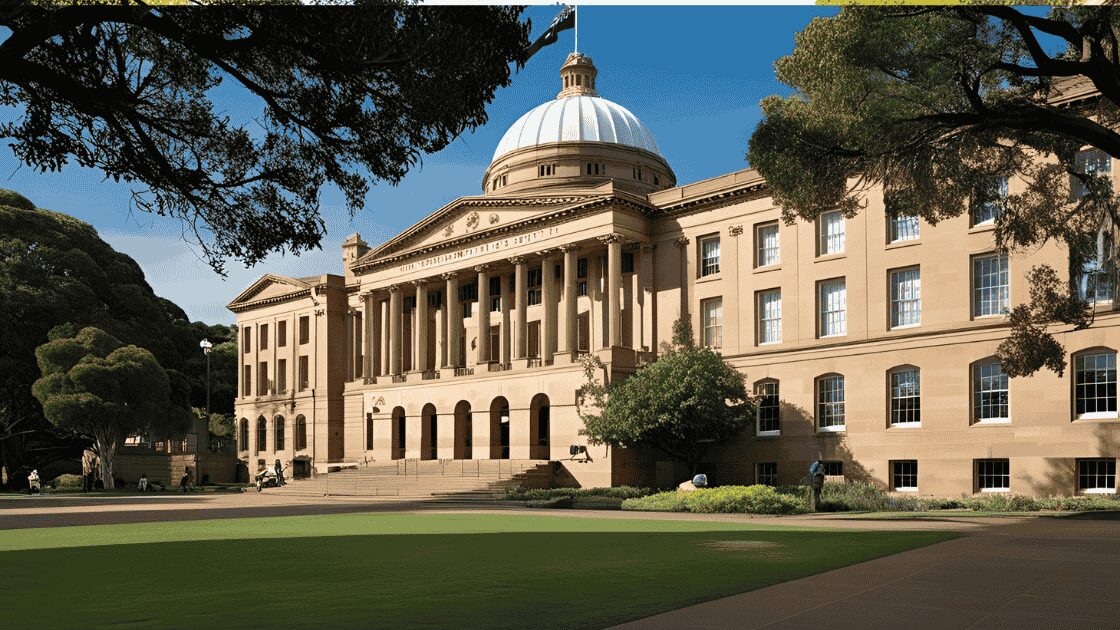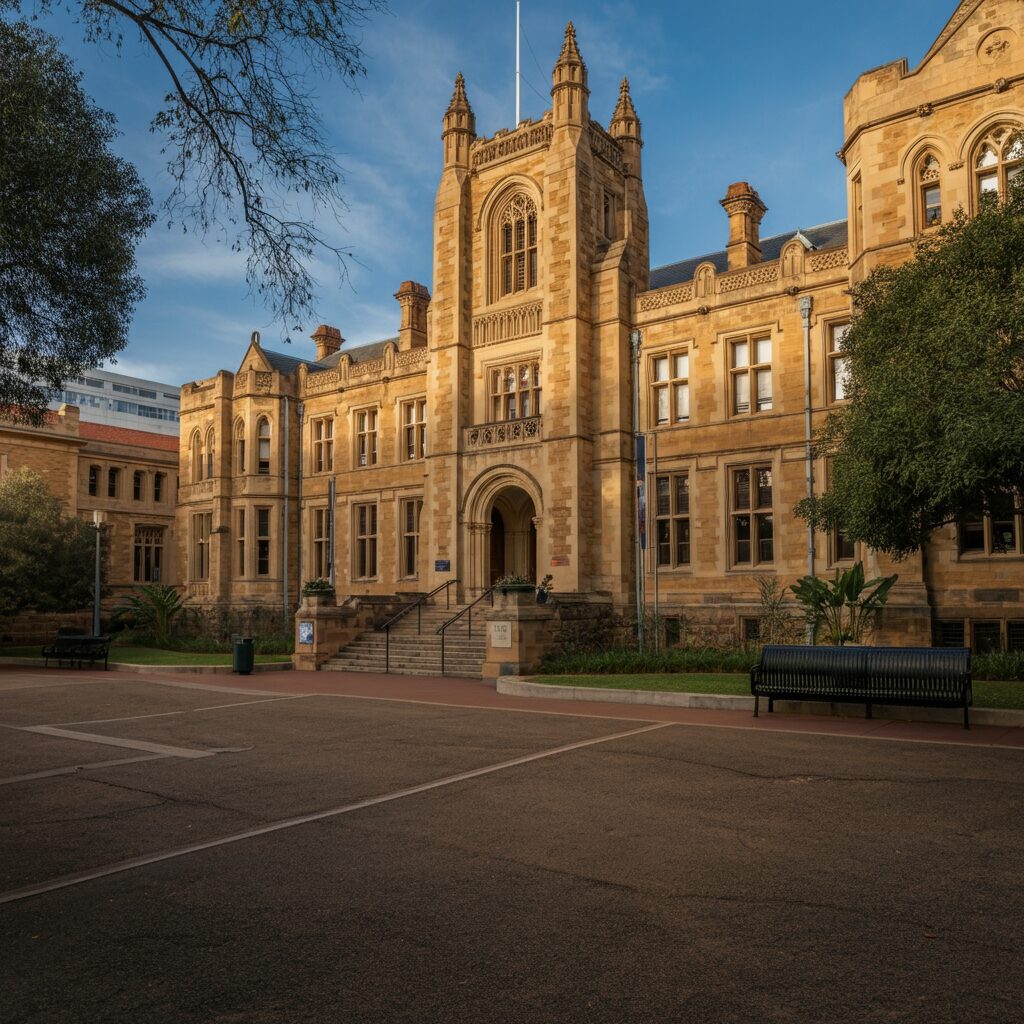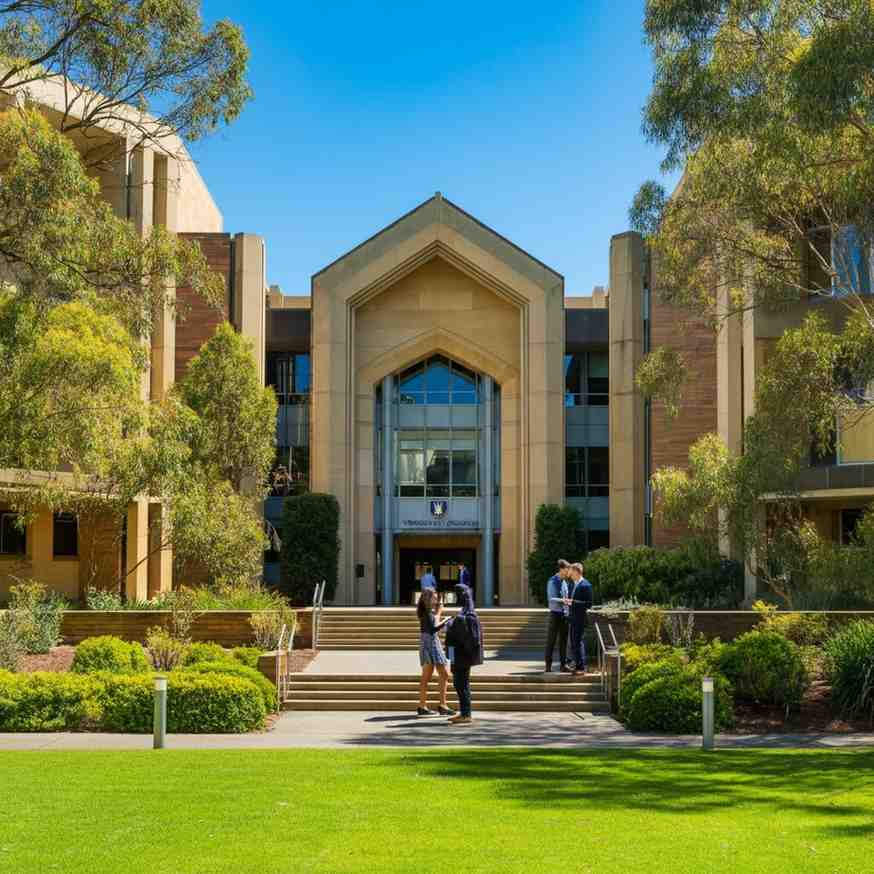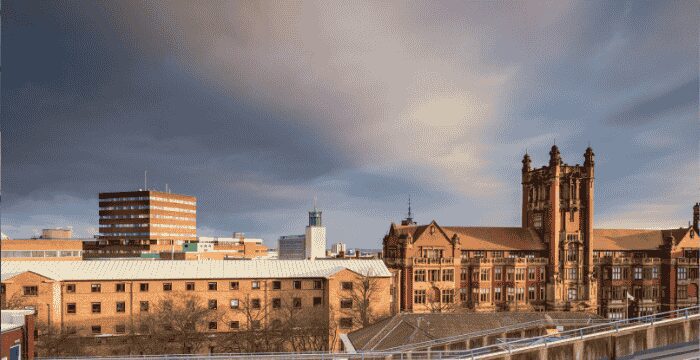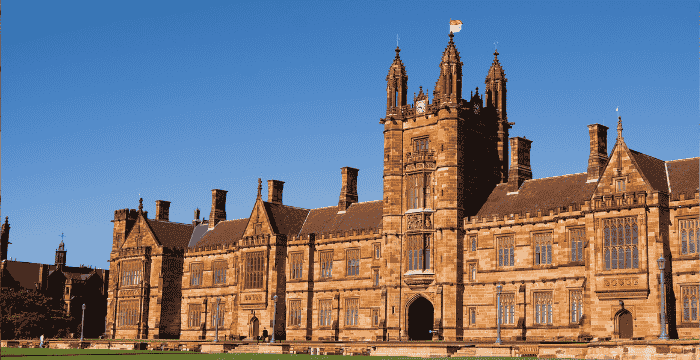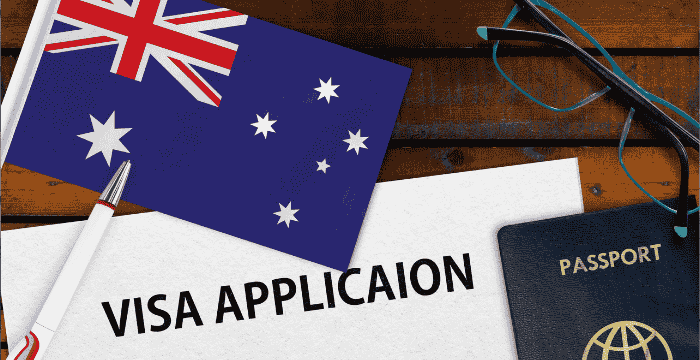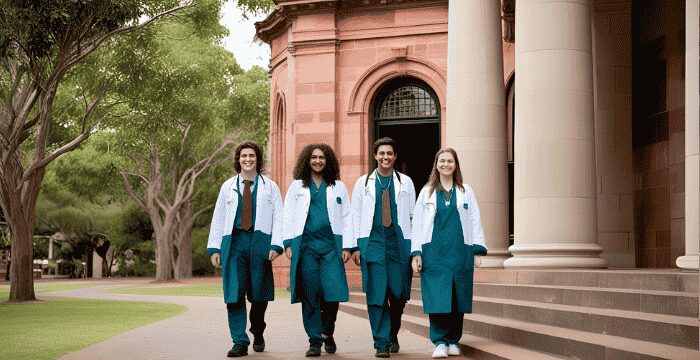Pursuing a globally respected medical degree that allows high earnings and makes international practice easy? Learn why Australia stands out as the most popular destination for Indian students studying MBBS in 2025.
There is growing interest among Indian students who choose to study medicine in Australia. With world-class qualifications and modern campuses, obtaining an MBBS degree in Australia brings many benefits to medical students. You will find all the details on admission, costs, scholarships, the best universities, and job opportunities for Indians who want to pursue medicine studies in Australia in 2025.
What makes Australia a good choice for studying MBBS in 2025?
Due to the great education and global job options, courses in MBBS in Australia are becoming more popular among Indian students. An Australian medical degree is valued by the Medical Council of India (MCI/NMC), which means graduates can practice in India without clearing other exams. Being recognised in this way allows you to explore legal practice opportunities in other nations.
The high quality of medical education in Australia is reflected by the frequent ranking of Australian universities worldwide. As an example, the located in Melbourne, Australia, this is the University of Melbourne. It is ranked first for medicine in Australia and 20th globally in 2025. Due to their advanced skills, MBBS graduates can expect to see their employment chances rise by almost 25% within five years in Australia.
Beyond learning, students can live safely and enjoy the variety of cultures while gaining real clinical opportunities throughout their studies in Australia. Graduates from medical schools trained in this way are well-equipped to handle problems that occur in healthcare.
Indian students in Australia will find a good community among other Indians, useful support services, and clear ways to work after graduation and apply for permanent living status.
MBBS in Australia for Indian Students: Eligibility & Requirements in 2025
All Indian students interested in MBBS in Australia must follow certain rules to maximise their chances of success.
Academic Qualifications
- Completed my higher secondary education focused on Physics, Chemistry, and Biology.
- Most universities require academic scores ranging from 65% to 90%.
- Good skills and performance in courses like Biology and Chemistry.
- Finishing the required courses listed by individual colleges.
Entrance Exams
- UCAT ANZ: UCAT ANZ is needed for most Australian medical school admissions.
- GAMSAT: GAMSAT (Graduate Medical School Admissions Test) is needed for admission to graduate medical courses at universities, such as Deakin, Melbourne, Sydney, and the Australian National University.
- Indian students interested in MBBS in Australia must have NEET certification, especially if they hope to practice in India as well.
- 50% or above is the minimum percentile required for general category Indian students taking NEET.
Speaker/Writer Effectiveness in English
- IELTS requires a minimum score of at least 7.0 and should not have a band lower than 6.5.
- TOEFL iBT results range from 72 to 100.
- Some universities will consider other English proficiency tests, such as PTE Academic.
Additional Documents
- Describe in about 500 words why you are interested in studying medicine.
- A minimum of two academic and one professional Letter of Reference (LOR)
- Copies of academic transcripts that are officially marked as authentic.
- Make sure to feature the relevant working experiences in your updated resume or CV.
- Legitimate passport and visa certificates.
- Evidence that you will be able to cover your school fees.
- Insurance coverage for health care.
Adhering to these standards matters, as the number of medical school applicants in Australia is huge. It is important for Indian students to do more than the minimum and properly prepare themselves for any entrance exams and interviews.
MBBS in Australia Fees: Tuition & Living Costs in 2025
It is important to know about the monetary aspects of a medical education in Australia before you begin. MBBS in Australia fees vary significantly between universities and programs.
Fees Charged by Universities
The price of an MBBS in Australia for Indians is usually between AUD 30,000 (~ INR 16 lakhs) and AUD 80,000 (~ INR 42 lakhs) each year. This is a list of fees at some of Australia’s leading medical schools:
| University | Tuition Fees per Year (AUD) | Tuition Fees per Year (INR) |
| University of Melbourne | 101,952 | 57 lakhs |
| University of Sydney | 88,500 | 49 lakhs |
| Monash University | 70,000 | 37.15 lakhs |
| University of Queensland | 91,819 | 51 lakhs |
| University of New South Wales | 74,445 | 41 lakhs |
| Australian National University | 90,130 | 50 lakhs |
| University of Adelaide | 89,500 | 50 lakhs |
| University of Western Australia | 85,800 | 48 lakhs |
| University of Newcastle | 72,705 | 40 lakhs |
| Deakin University | 80,600 | 45 lakhs |
Price of Living in Australia in 2025
Apart from paying for tuition, students need to set money aside for other needs. On average, students from other countries can expect to spend AUD 2,600 a month (INR 1.46 lakhs) excluding rent while studying in Australia. The breakdown of typical monthly expenses is as follows:
| Expense Type | Average Cost (AUD) | Cost Equivalent (INR) |
| Accommodation | 2,100 | 1.18 lakhs |
| Food | 400 | 22,500 |
| Travel | 170 | 9,500 |
| Internet | 120 | 6,700 |
| Utilities | 330 | 18,500 |
| Miscellaneous | 200 | 11,200 |
Advice for effective financial planning.
- Get in touch with scholarship and financial aid programs in advance.
- Sharing a house with others can save you money on housing.
- Make use of offers for students on buses, movies, and many other services.
- Review the available part-time jobs during the term (up to 40 hours every two weeks) and during breaks (with no limit).
- Consider setting up an Australian banking account to receive the exchange rate with fewer penalty fees.
- Watch your budget and keep track of how you use your money.
The MBBS degree in Australia may be costly, but it usually costs less than similar degrees in the UK or the US. Another benefit is that doctors in Australia are the highest earners, earning an average of AUD 210,000 (about INR 1.18 crore) yearly.
Best Medical Colleges in Australia for Indian Students in 2025
Outstanding medical programs from famous universities are available in Australia. When choosing where to study MBBS in Australia for Indian students, consider factors like global rankings, program structure, clinical opportunities, and support for international students.
The Top 10 MBBS Universities In Australia
- University of Melbourne
To do MBBS in Australia, Melbourne was listed as the top-ranked university in Australia and ranked 20th globally for medicine in 2025.
- University of Sydney
To do MBBS in Australia, Sydney is at 2, while globally it is ranked #26 for excellent medical training, involving research and global connections.
- Monash University
Above all, to do MBBS in Australia, Monash scores 3 in Australia and 40 worldwide, providing medical degrees for students with different entry levels and improved learning approaches.
- University of Queensland
To do MBBS in Australia, UQ ranks fourth; globally, it stands at 66th, and students benefit from exceptional clinical placements and research.
- UNSW Sydney
It stands for the University of New South Wales.
To do MBBS in Australia, UNSW ranks 5th in Australia and 54th worldwide for having research as its key priority and working on global health.
- Australian National University (ANU)
To do MBBS in Australia, ANU is ranked 8th in Australia and 150th around the world, with a unique graduate-entry medical program and small classes.
- University of Adelaide
To do MBBS in Australia, Adelaide, Australia, stands in 6th place within the nation and 131st worldwide, thanks to its emphasis on rural clinical education.
- University of Western Australia
To do MBBS in Australia, UWA is ranked eighth, and it ranks 132nd worldwide with its four-year MD course and great opportunities for research.
- University of Newcastle
To do MBBS in Australia, the city of Newcastle ranks 9 in Australia and 188th globally, famous for its innovative way of learning by solving problems.
- Deakin University
To do MBBS in Australia, the Medical School at Deakin University gives students the opportunity to focus on learning about rural and regional medicine for four years.
Important Factors to Keep in Mind
- Pay attention to these aspects when making your decision about a university.
- The difference between entering university as an undergraduate or a graduate student.
- Different types of clinical internships.
- Study what resources are available and what can be done.
- Provide help for students from other countries.
- The region’s housing costs and where you can reside.
- Scholarship availability
- The percentage of graduates who have jobs.
In Australia, most medical schools use a problem-based approach, enabling students to get early clinical experience, along with their studies. By putting great emphasis on research, the program prepares students for jobs in academia and innovation related to medicine and healthcare.
Understanding the Steps to Apply for Scholarships for MBBS Study in Australia
Studying medicine in Australia can be very expensive, yet there are plenty of scholarship options for Indian students.
1. Primary Scholarships for Pursuing MBBS in Australia
Scholarships are funded by the Australian government.
Australian government scholarships are for international students and include tuition, travel, and living costs.
2. Monash University Merit Award for International Students
International students who excel academically can receive financial aid from this institution.
3. The Sydney Achievers International Award
The University of Sydney provides funds to talented overseas students who excel in their studies.
4. JCU offers the International Excellence Scholarship.
Helps students from different countries who have excelled academically at James Cook University.
5. Undergraduate Research Scholarships India
Created for Indian students looking to pursue studies at the Australian National University.
6. University-specific Scholarships
Many universities across the world offer scholarships for those in the health and medical fields who show great promise.
7. Australian scholarships for international students
Supports international students who are studying at regional universities in Australia.
8. Tasmania Scholarship and Prize Program.
The University of Tasmania presents financial support options for students.
9. Deakin Warrnambool offers an International Residential Scholarship program.
Helps organise housing for international students attending Deakin University.
10. Scholarship provided by the Vice Chancellor for international students.
Accepted for admission by various universities for those with outstanding international achievements.
How to Apply for Scholarships in 2025?
To ensure you have the greatest chance of getting financial aid:
- Make sure to begin your search for scholarship opportunities at least one year or so before your enrollment date.
- Make sure all your requirements are fulfilled before applying.
- Write a statement that shows your best achievements, future plans, and your request for assistance.
- Provider supporting paperwork, such as your transcript, letters from recommenders, and your finances.
- Send your applications in early, as many scholarships are awarded on a first-come, first-served basis.
- Seek out many scholarships to give yourself a better opportunity to be chosen.
- Check opportunities that are given by your university and outside sources.
The amount of scholarship assistance can be between AUD 10,000 and AUD 100,000, covering part or most of your costs of studying and living. Since the scholarships are very competitive, you need to do well in school, have good activities outside of school, and write a quality application to succeed.
Accessing the Admission Process for MBBS in Australia in 2025
You must plan and prepare well to get into an MBBS in Australia. Follow this procedure to complete your application easily.
Step 1 – Find out about universities and create a list of choices.
Check out schools based on your grades, funds, and career choices from the start of your search. Look at these kinds of issues:
- The design and duration of the program.
- Information on eligibility and success rates.
- Tuition costs and scholarships are available.
- Location and facilities at the campus.
- Medical student placements in hospitals.
- Students’ achievements and their rates of employment.
- Identify a list of 5-8 universities where you qualify for admission and where their programs fit what you are looking for.
Step 2 – Get ready for Entrance Exams and English Tests
Apply and prepare as needed for the set of examinations:
- NEET (in reference to the Indian education system)
- UCAT ANZ is an admissions test for undergraduate courses.
- Should you take the GAMSAT or MCAT if you want to apply for medical school?
- You should choose between IELTS and TOEFL to demonstrate your English skills.
Prepare ahead of time and practice with past exams so you know what to expect in the test. You should consider coaching if you have trouble with your preparation for the UCAT or GAMSAT tests.
Step 3 – Get the Required Documents
Compile all the important items for the application.
- Documentation that includes an academic transcript and certificates.
- Written statement discussing the objective (about 500 words).
- At least 2 academic and 1 professional letters of recommendation are required.
- Updated CV focused on important exercises.
- Documents that prove a person’s identity.
- A demonstration of ability in English.
- Financial reports, including letters of sponsorship
- Depending on the situation, reports from medical examinations may be needed.
Emails and documents should be officially translated from their original language to English.
Step 4- The next phase is to fill out the online job application.
The majority of universities in Australia allow you to apply online via their websites.
- Apply for accounts on university application platforms.
- Finish all necessary sections correctly
- Upload documents in the listed formats only.
- You are required to pay the application fee, which costs AUD 50 to AUD 200.
- Make sure to apply before the deadlines.
- Keep your application references and login details somewhere safe.
In New South Wales, many universities use the centralised Universities Admissions Centre (UAC) for applications.
Step 5- Attend and cooperate in all the requested job interviews if you must.
If your application is selected, get ready for the interview process.
- What are the most common questions during medical school interviews?
- Try practising by doing mock interviews.
- Become ready to share your reasons for medicine, ethical situations in the field, and your plans for the future.
- For MMI, prepare for various small interview simulations.
- If you are unable to come in person, request online meetings instead.
During interviews, people are evaluated for their academic skills as well as their ability to relate and solve ethical issues.
Step 6 – Receive the Offer Letter and Secure a Visa
After getting an offer:
- Complete the process and accept within the stipulated time.
- Be sure to place your deposits as required.
- Look up how to apply for a Student Visa (Subclass 500).
- Purchase health insurance for your travel (Overseas Student Health Cover is compulsory).
- Make reservations for both accommodation and travel.
- Book places to stay and ways to travel.
- Attend discussions or sessions before the trip.
The procedure from research to getting accepted may take up to a year, so you should get started as early as possible.
What is the course structure and curriculum for MBBS in Australia in 2025?
The Australian system of medical education is set up to create doctors who are smart, skilful, and compassionate. Learning at the school includes both classroom theory and practice in clinical settings.
Pre-Clinical Years
At the start of MBBS in Australia, students learn the fundamental medical information.
In Basic Medical Sciences, the topics are Anatomy, Physiology, Biochemistry, Pathology, Pharmacology, and Microbiology.
Clinical Sciences Introduction: Learning basic skills in medicine, ethics, and talking to patients.
Problem-based learning: Using case studies and scenarios to improve clinical thought.
Ways Research in the Medical Field: How Medical Research and Evidence-Based Care Work
Medical Ethics, Healthcare System Structure, and the Relationship between Doctors and Patients
Most of their time in these years is spent doing classroom learning, laboratory experiments, and practising in clinical simulations. Most Australian medical schools, though, offer clinical exposure through visits to hospitals or clinical observerships.
Clinical Years
Later in the program (generally 3–6 years for undergraduate, and 2–4 years for graduate), there’s more emphasis on hands-on rotations and practical learning.
- Clinical Rotations: In Clinical years, students spend time learning in many areas: Internal Medicine, Surgery, paediatrics, Obstetrics and gynaecology, Psychiatry, and Family Medicine.
- Hospital Placements: Repeated placements are connected to training in hospitals where health professionals work.
- Rural Clinical Schools: Most of these programs require students to gain experience in rural communities.
- Elective Rotations: Students are able to do rotations in areas that spark their interest or abroad.
- Research Projects: A number of these programs feature research or scholarly activities as part of the curriculum.
By working directly with actual patients, students acquire the skills they have learned in the classroom.
Specialist Courses & Gratifying Choices
New options for specialisation and elective subjects are available to students in Australia.
Medical Chemistry: Studying how drugs are made and how they act in the body is Medical Chemistry.
Microbiology: Microbiology is about studying microorganisms that cause diseases.
Physiology: The study of how the body is made up and how it functions.
Oncology: The discipline devoted to the study of cancer care is called Oncology.
Gynaecology: Gynaecology involves the study of women’s reproductive systems.
Cardiology: Cardiology refers to the study of the heart and our circulatory system.
Emergency Medicine: How emergency medicine works during urgent and life-threatening situations
Healthy living: Putting policies and interventions in place for whole communities
Medical Research: Chance to learn about medical research in hands-on laboratory settings.
These subjects let students learn about areas they’re interested in and could help them choose a career path.
MBBS in Australia course places importance on applying evidence, focusing on patients, and building ongoing learning skills. Today’s healthcare professionals must be able to use both theory and practice when dealing with the challenges of healthcare, and this is what training for them is intended to do.
Career Opportunities Following an MBBS in Australia in 2025
Earning an MBBS in Australia allows students to follow their calling in Australia and many other countries, such as India.
Jobs and Their Compensation
Those who graduate in medicine from Australian institutions have multiple opportunities for well-paying jobs.
- A General Practitioner earns around AUD 182,000 per year (nearly INR 1.02 crore).
- An average annual salary for an Orthopaedic Surgeon is roughly 1.39 crore in Indian rupees or AUD 248,300.
- A psychiatrist can expect to earn about AUD 238,000 per year, or about 1.33 crore INR.
- A family physician can expect to earn approximately $112,150 every year, or INR 63 lakhs.
- It takes approximately INR 1.55 crore to earn USD 281,200 for a cardiologist annually.
- A physiotherapist earns around AUD 88,000 a year, which is equivalent to about INR 49 lakhs.
- A nuclear scientist in Australia earns about AUD 120,000 per year, which equals INR 67 lakhs.
Across Australia, jobs for medical professionals are on the rise, showing a strong range of 11-25% growth in opportunities in the coming five years. The increase is caused by Australia’s expanding older population, the rise of healthcare, and the ongoing need for trained medical practitioners.
Latest Process of Getting Permanent Residency in 2025
Australia makes it clear that permanent residency is possible for international medical doctors.
- Temporary Graduate Visa (Subclass 485): International students can remain in Australia for 2-4 years after finishing their studies to improve their skills through work.
- Skilled Independent Visa (Subclass 189): For individuals with jobs that are on the Medium and Long-term Strategic Skills List (MLTSSL) and have medical backgrounds, a Skilled Independent Visa (Subclass 189) is available.
- Skilled Nominated Visa (Subclass 190): The Subclass 190 visa is comparable to the 189 and calls for nomination from an Australian state or territory.
- Regional Skilled Migration: A new way for doctors to apply for jobs in regional areas where healthcare is needed.
Because Australian health services are always in demand, medical professionals are highly valued for migration purposes.
Going back to India after completing MBBS in Australia.
If you are an Indian medical graduate in Australia, the Medical Council of India will allow you to practice in India without going through extra exams. Your reputation in this field means you can work in either nation or travel between them.
In order to practice in India, graduates must:
- Get yourself registered with the Medical Council of India.
- Make sure all paperwork has been verified.
- Meet all the requirements set by the individual state medical councils
Graduates from Australian medical schools are well placed to work in other countries, such as the UK, the US, Canada, and New Zealand, due to a simple registration process made possible by the good standing of Australian medical education globally.
Comparing MBBS in Australia to MBBS in other countries
It helps to compare Australia’s medical education system with others when you’re thinking about learning abroad
| Country | Duration | Fees (per year) | Recognition | PR Options |
| Australia | 5–6 yrs | AUD 40k–80k | Global | Yes |
| UK | 5–6 yrs | GBP 25k–40k | Global | Limited |
| US | 8 yrs* | USD 40k–60k | Global | Yes |
| India | 5.5 yrs | INR 2–15 lakhs | India | N/A |
Global Career Exploration
If you are an Indian student content with quality education, a well-known degree, affordable fees, and decent job opportunities, an MBBS in Australia is a great option worldwide.
Student Life, Housing & Support in Australia
You will gain the most out of your time in Australian medical school by enjoying a positive and enriching student experience.
- Campus Facilities & Assistance for Students
- Many Australian universities are committed to helping international students.
- The International Student Office is there to help with visas and to make students feel comfortable in a new environment.
- Assistance for studies: Tutoring, group studying, and learning programs
- The service provides counselling, psychological counselling, and wellness activities.
- You can get assistance with making your resume, practising for interviews, and job searching.
- On campus, there is access to health services, and you can get healthcare.
- These groups are formed to support and protect student interests and to organise entertainment for students.
- There are good libraries and places for individual and group study at the school.
Gyms, swimming pools, sports fields, and team sports are amenities at a typical gym.
Many schools of medicine also arrange for students to join clubs or programs run by older students as well as professionals.
What You Can Get at Each Price Point
A range of homes is here for those who have various needs and budgets.
- On-campus living spaces where meals are available (AUD 200-500 per week).
- Residential Colleges: Standard accommodation offered by universities for support and fun (AUD 300-700 per week).
- Sharing Apartments: Students pay between AUD 150 and 350 a week to rent off-campus housing with others.
- Living with a local family and enjoying three meals for AUD 250-350 per week.
- These apartments are designed for individuals to live independently (prices range from AUD 300 to AUD 600 per week).
Most colleges and universities provide services to help overseas students find comfortable housing, and usually reserve on-campus housing for international students during their first year.
Culture and Society
Australia is known for its multicultural population and many chances for social involvement:
- Various Indian student societies and cultural associations are a part of many universities.
- Offering assistance for people to practice their religion.
- Diwali and Holi celebrations of Indian traditions, alongside others.
- Recreation and Sports support for people to get involved in known or unfamiliar sports.
- Community service projects let you learn, interact and be a part of the community.
- Breaks Give You the Chance to See Australia’s Incredible Landscapes and Cities.
The people in medical programs usually gather to celebrate events and create a strong sense of belonging. Being part of a medical education community in Australia helps you form healthy professional relationships and lasting friendships for your career.
MBBS in Australia: Applications & Deadlines in 2025
You need to plan when and how to apply carefully for MBBS in Australia. Most universities in Australia have two main periods when students can begin studying: February and July. However, medical courses usually admit students in February only.
One to Two Years Before Start Date
- Study universities and available programs.
- Review what is required and what exam you need to take.
- Prepare yourself to take standardised NEET, UCAT and GAMSAT tests.
- Look into or begin to allocate savings for financial aid.
12-18 months before the Start Date
- Take steps to apply for and sit in the entrance exams.
- Be ready for and take the IELTS/TOEFL tests in English.
- Start accumulating papers for application procedures.
- Look for scholarships available to students.
10-12 Months Ahead of Start Date
- Universities usually accept applications between May and September for the February intake.
- As regards letters of recommendation.
- Improve how I write my statements in my personal or school applications.
- Try to obtain scholarships.
Approximately 6-8 months before the start date.
If you are shortlisted, you should attend interviews.
- Accept and deal with offers.
- Place a deposit to reserve a place
- Apply for a student visa with subclass 500.
- Secure your health insurance (OSHC).
3 to 4 months ahead of the start date
- Obtain a visa approval in Singapore.
- Book flights
- Arrange accommodation
- Look after your money and banking tasks.
- Make sure you attend all briefings before taking off.
A month prior to the start date.
- Organise travel plans.
- Make sure you have the right clothes for Australia’s climate.
- Send an email to the university with your trip plans.
- Make sure you are prepared for orientation.
When to Submit Key Application Information
Though dates vary between universities, these are the general times when articles are due.
- If you want to study at the University of Melbourne in February, applications need to be submitted by late May or June.
- It is necessary to submit your application by September for entry in February at the University of Sydney.
- The deadline for applications for the February intake at Monash University is August.
- Prospective students should apply by September for January admission at the University of Queensland.
- If you want to join UNSW Sydney for the February intake, applications must be completed by September.
Students from outside the country should send in their applications well ahead of time, since popular programs may fill quickly. Students should keep in mind that most scholarship applications have an earlier deadline than the usual admissions period.
Conclusion
For those from India hoping for a great medical education abroad, an MBBS in Australia is a great chance. Because of excellent education, multiculturalism, and good career possibilities, Australia is becoming more attractive to Indian medical students.
Getting into medical studies in Australia includes organising everything from exams to finances. Although the cost is high, students get an excellent education, worldwide exposure, and many job prospects as a result.
Australian medical degrees meet Indian recognition standards, so Indians working in Australia do not need more screening exams. Graduates from this course have the potential to pursue different careers around the world and, potentially, obtain permanent residency in Australia.
In India, students interested in studying MBBS in Australia should begin their preparation ahead. Study thoroughly the universities you are interested in, get ready for the tests, and seek out several scholarship options. If you plan and prepare, starting your career in healthcare internationally after getting your medical degree from Australia is possible.
FAQS( Frequently Asked Questions)
Q1. Is it necessary to take the NEET to study MBBS in Australia?
Yes, to be eligible for MBBS in Australia for Indian students, they should pass NEET if they want to return to practice medicine in India. Students from the general category in India should ensure they have achieved at least 50 percentile in NEET.
Q2. Can MBBS graduates from India practice medicine locally, once they have completed their course in Australia?
Yes, doctors with MBBS degrees from Australia are recognised by MCI/NMC in India, so they can start practising without passing an extra examination. As a result, you can work in Canada or abroad.
Q3. How much can a student expect to pay for MBBS in Australia?
The fee a student pays for MBBS in Australia can be between AUD 30,000 and AUD 80,000 (or INR 16 lakhs to INR 42 lakhs), depending on where they study. On top of your living expenses, you can expect to spend about AUD 2,600 (INR 1.46 lakhs) every month.
Q4. Can MBBS students in Australia receive scholarships?
There are numerous scholarships provided by the government and various universities for both Indian and international students. The amount you receive through a scholarship could vary from AUD 10,000 to AUD 100,000.
Q5. For how long does it take to complete MBBS in Australia?
The basic Bachelor of Medicine, Bachelor of Surgery (MBBS) course is around 5-6 years if taken directly after high school, while graduate-entry MD courses are only 4 years. Many Australian universities give the degree under Doctor of Medicine (MD), even though the program is still equivalent to MBBS.

